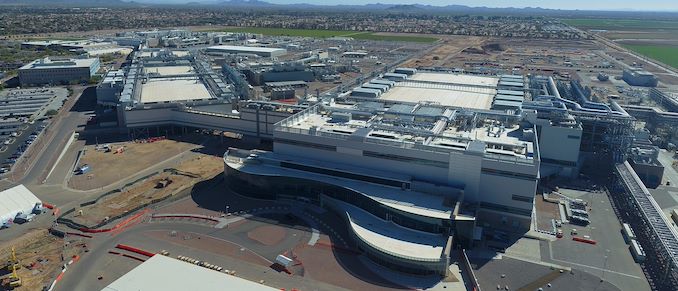Intel Accelerated Webcast on July 26th: Update on Process Technology and Roadmaps
by Dr. Ian Cutress on July 12, 2021 10:51 AM EST- Posted in
- CPUs
- Intel
- GPUs
- 10nm
- 7nm
- Packaging
- 3D Packaging
- IFS
- Intel Foundry Services
_678x452.jpg)
Earlier this year, new Intel CEO Pat Gelsinger outlined his new ‘IDM 2.0’ vision for Intel. This vision was a three-pronged strategy based on improving its own process node technology, mixing in other foundry technology where needed, and also realigning its manufacturing for a new foundry service offering allowing other semiconductor companies to use Intel’s manufacturing expertise. As part of the journey towards Gelsinger’s IDM 2.0 vision, we were told to expect updates at a more regular cadence, and the announcement of ‘Intel Accelerated’ in a couple of weeks is the next event on the calendar.
Intel IDM 2.0
As AnandTech reported back in March, Intel’s IDM 2.0 strategy features the following:
- Build (on Intel 7nm)
- Expand (use TSMC and others)
- Productize (Intel Foundry Services)
Previously Intel was almost completely insular, preferring to use its own technologies almost exclusively, and it kept them to itself. Through IDM 2.0, CEO Pat Gelsinger is hoping to drive Intel’s next wave of products by using the best the market has to offer, but also expand Intel’s own manufacturing to new customers as a potential revenue stream. The guise of this development is also in the sense of aligning semiconductor manufacturing outside of Asia, to make other areas of the world less reliant on a single resource.
Part of this strategy requires Intel to execute on its research roadmaps. Intel’s struggles to enable 10nm in suitably high volumes have been the focus of plenty of column inches, and while Intel is now shipping 10nm Tiger Lake-H in the millions* and 10nm Ice Lake Xeons in the hundreds of thousands*, there is a need to address the future of Intel’s manufacturing. This means making sure it aligns with commercial interests and enables a competitive offering against the competition. This covers not only manufacturing, to which Intel announced a $20b investment in its Arizona manufacturing earlier this year, but also advanced packaging technologies, where Intel announced a $3.5b investment in its New Mexico facilities in May.

Intel's Ocotillo Campus, Arizona
Part of creating its Intel Foundry Services offering for external parties to use Intel manufacturing relies on Intel being more open about its technology and showcasing progress in its research and development, perhaps to a degree more than it has done in the past. Any future customers of Intel’s IP portfolio will want to know what is coming down the pipe, especially when silicon development takes years and getting the right timing in the alignment of technologies becomes very important in these competitive markets. Having a platform to showcase Intel’s roadmaps is what this upcoming Intel Accelerated Webcast seems to be about.
Intel Accelerated
On Monday July 26th, 2pm Pacific, Intel will livestream its Intel Accelerated webcast. The topics of the day are presentations from CEO Pat Gelsinger and Dr. Ann Kelleher on Intel’s process node technology development and roadmaps into Intel’s packaging portfolio. Dr. Ann Kelleher is Intel’s SVP and GM of Technology Development, and the person in charge of all of this.
We are hoping that this webcast will go into detail as to where Intel expects its 10nm development to go on SuperFin/Enhanced SuperFin, leading into discussions about 7nm. While Intel won’t be discussing things like buried power rails or new manufacturing techniques, we will hopefully see a disclosure more akin to TSMC and Samsung’s Foundry events that happen yearly regarding what variations of process node development are being targeted.
On the packaging front, we know that Intel has EMIB, Foveros, and ODI under research up against TSMC’s 3DFabric, so insights into how Intel is developing its technology will be welcome by both the semiconductor industry but also the financial markets. Interestingly enough, while this event is on the 26th, Intel’s quarterly financial disclosures are on the 22nd, a few days prior. On Intel’s packaging, as the company moves into its Client 2.0 strategy of drilling everything down into silicon IP blocks, understanding exactly how those will all be connected becomes a vital element to the future of Intel.
The event will be open to all on Intel’s Newsroom.











28 Comments
View All Comments
johannesburgel - Monday, July 12, 2021 - link
Broadly sampling? There are still no Sapphire Rapids ES2 chips around.yeeeeman - Tuesday, July 13, 2021 - link
Lets not forget that this kind of thinking towards Intel has been predicated in 2015 towards AMD, that it couldn't make any comeback and boy they did!Gondalf - Wednesday, July 14, 2021 - link
Too far away ?? are you sure about this?? with Intel and Apple hardly pressing about ?? :) come on be realistic. After all, looking carefully TSMC 3nm is only less than 26% more dense than Intel 7nm (at the cost of some expensive double exposures with EUV), so Intel want it to have more volume, definitively 3nm is not for performance and average power reduction, they can have the same doing a 7nm+ or 7nm++ spending less money thanks to the single exposure..Intel want to charge the huge amount of bad wafers on TSMC instead on itself.
Unfortunately Amd is out of this big boys game and even on plain 7nm it can not deliver to customers. Funny enough in these days being an IDM is an advantage.
You can deliver, your competitors NOPE.
Spunjji - Tuesday, July 13, 2021 - link
It's a fun game triangulating troll accounts on different sights by taking note of which ones post this same un-sourced shite.Silver5urfer - Monday, July 12, 2021 - link
Too much of talk and no actions to prove is what Intel nowadays, their talk is essentially BS with latest corporate policies infused in absolutely shameless Intel.Rocket Lake was sandbagged by the slow cache ruining it's IPC gain and runs way hotter than 10900K, what a joke to make it worse the IMC has been castrated now, CML can run 4000MHz with ease on 10th gen but 11th gen cannot even run stable at 3733 awful trash. HEDT has been dead since ages.
As for me the only advantage Intel has is, Stable clock speed. No matter which CPU you pick up it will run at the Clock you set, no dynamic BS drama like AMD no core recycle BS no Windows Powerplan drama (I know this is due to scheduler for AMD CCD chiplets and UEFI BIOS CPPC etc). Second thing is most of the Intel HW can run Win7 without issues (yeah I want that OS, personal preference as it runs all stuff very reliably and looks much nicer than 10 and 11 and no telemetry BS, it has Updates, go to update catalog and check for yourself). Third is no USB Stability sporadic problems like AMD. Yes they have some HW BS like Foxville disaster needing 3 HW revisions to fix.
Keeping that aside, looking at the 10nm TGL is maybe fine, but its a BGA product, useless junk in 3-4 years and the BIOS on those machines is absolutely pathetic, Yep it can run games at high FPS no question but it's not a great product to point out as wow, wasted potential. Should have released an LGA1200 10C variant on Desktop.
Now Intel is going even more anemic garbage like BigLittle. Horrible shame. First copied AMD's chiplet with that Intel Xe, later Gear memory crap, now from ARM inferior small pathetic cores. While Apple is ramping up big cores in their own Silicon production. All because $$$$$ low key junk laptops sell a ton more so why not collude with M$ and push for junk irreparable trash with inferior performance. Muh Battery life. But that is now even in Desktops because unable to compete against AMD's SMT technology leadership.
JayNor - Monday, July 12, 2021 - link
Gracemont may be 1/3 the area of the Golden Cove cores. Still runs x86. Runs avx2 simd, like AMD cores. Have to wait and see on the performance ... looks like they will have SKUs with no Gracemonts, so no one is forcing you to buy the small cores.Silver5urfer - Tuesday, July 13, 2021 - link
12900K ES jst got a leak. It's scoring 11K marks on CBR20. That's stomping 5950X but probably it's at 5.3GHz, dunno the power draw or the max TDP and how much role does Gracemont cores play a role and how their clock speed varies.AMD boldly put out V-Cache Zen3+ already at 15% gaming boost, with confidence. And Zen 4 AM5 will launch in 2022 Q3-4, by that time Intel Raptor Lake is also coming, just based on this rumor of ADL leak, Intel is somewhat back in the game..Still gotta wait and see.
Dizoja86 - Monday, July 12, 2021 - link
Tell us how you really feel....sseemaku - Monday, July 12, 2021 - link
Engineers in American and European companies can never spend the man hours Chinese and Taiwanese do. Don't think Intel can again lead in semiconductor manufacturing like it used to do.whatthe123 - Monday, July 12, 2021 - link
Taiwan has the expertise. China has dumped ungodly amounts of money and gotten nowhere near samsung/tsmc/intel even after stealing IP and subsidizing every loss. fact that TSMC has swung out in front just tells you it's not as simple as throwing man hours at the problem.